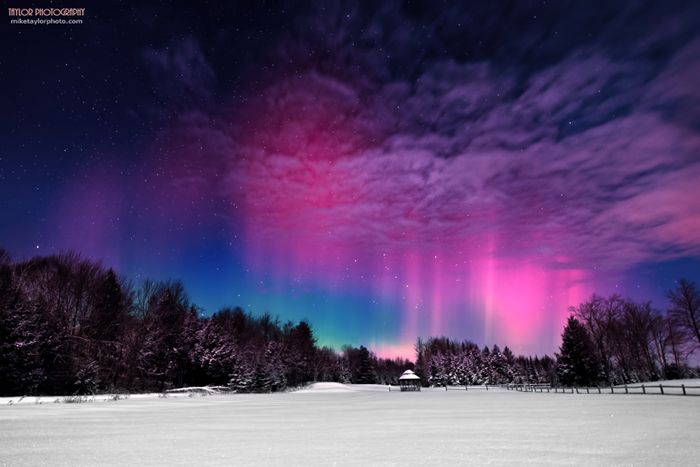
Aurora at Moonlight

Mike Taylor is an accomplished landscape astrophotographer who offers night photography and post-processing workshops. Taylor contributed this article to Space.com's Expert Voices: Op-Ed & Insights.
On the morning of Feb. 19, the spikes of the Northern Lights were quite strong when I first headed out to see what I could capture close to my home in central Maine. The cloud cover quickly moved out, but then came back after about a half hour — I almost missed the show!
This scene was captured in the beginning of that 30-minute window. I was not expecting the pink and red hues to be so strong since I couldn't see them with my naked eye, but the camera certainly captured the colors. [How Cameras Reveal the Northern Lights' True Colors (Op-Ed)]
This was one of my test shots to check my camera settings and composition. The moon was very bright behind me as I was photographing — only five days since being at its full phase — and washed out a lot of the sky and the aurora , but made for some nice foreground lighting. The snow cover on the ground was over a foot thick and it took me a few minutes to get to a spot a couple hundred feet away where I liked the composition better than this scene, and by the time I continued shooting, the aurora display had calmed down quite a bit.

Thus this "test shot" was really my best capture of the show. I'm usually on top of aurora forecasts, but this one caught me a bit by surprise and I was fortunate to start photographing within five minutes of leaving my house.
During processing in the digital darkroom, I increased the color saturation and contrast a bit while actually bringing down the highlights to bring out the details in the sky as much as possible.
I photographed this image using a full frame Nikon D600 paired with the phenomenal 14-24mm aspherical wide angle lens @ 14mm using an aperture of f/2.8 with a shutter speed of 20 secs, an ISO setting of 800 and with my white balance set to a temperature of Kelvin 3570 on February 19, 2014 at 2:56 AM.
Sign up for the Live Science daily newsletter now
Get the world’s most fascinating discoveries delivered straight to your inbox.
The views expressed are those of the author and do not necessarily reflect the views of the publisher. Follow Taylor on his social media sites: https://www.facebook.com/miketaylorphoto, http://gplus.to/miketaylorphoto, http://pinterest.com/taylorphoto1, on his website http://miketaylorphoto.com and through his workshops at http://miketaylorphoto.smugmug.com/Workshops. Follow all of the Expert Voices issues and debates — and become part of the discussion — on Facebook, Twitter and Google +. The views expressed are those of the author and do not necessarily reflect the views of the publisher. This version of the article was originally published on Space.com.










